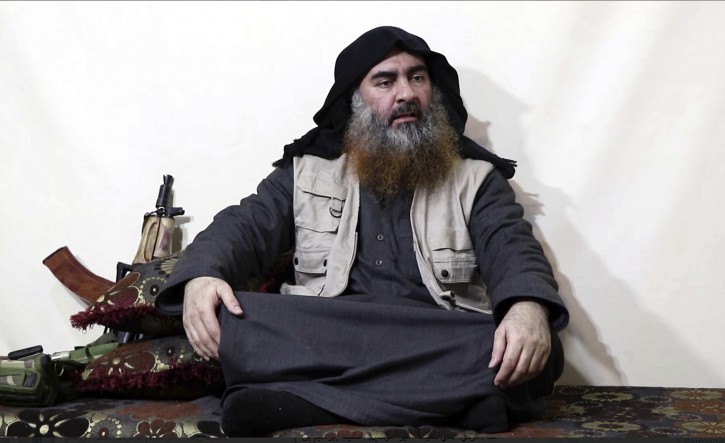 Beirut – They make threats from their hideaway lairs and celebrate mass attacks. The ending isn’t scripted for these hunted men with horrifying death tolls on their hands.
Beirut – They make threats from their hideaway lairs and celebrate mass attacks. The ending isn’t scripted for these hunted men with horrifying death tolls on their hands.
Subscribe to our Daily Roundup Email
When the reclusive Islamic State group leader Abu Bakr al-Baghdadi appeared in a video Monday, he was the latest in a series of most-wanted figures to use the medium to communicate with the outside world.
Al-Baghdadi’s goal was to dismiss suggestions of the extremist group’s defeat and his own often-reported demise, claim responsibility for the recent Sri Lanka bombings on Easter and warn of a “long battle” ahead.
In the video, released by an IS-run media outlet, al-Baghdadi — like others before him, such as Osama Bin Laden — wanted to show he’s alive and assure followers that the battle against “infidel enemies” continues.
“Audio and video messages by hunted figures is their way of rallying and reassuring followers that the group must carry on,” said Colin P. Clarke, a senior research fellow at the Soufan Center. “In some cases, these messages could be intended to motivate supporters to launch attacks, either as individuals on in small groups.”
With a bounty on their heads, the fugitives record their videos clandestinely. Props are important. Al-Baghdadi in his latest video mirrored a picture of bin Laden — sitting cross-legged with an assault rifle kept against the wall next to him.
Here’s a look at some infamous and in some cases, chilling video and audio communications from terror leaders to a deposed president on the run:
OSAMA BIN LADEN
One of the most notorious figures in modern history, the al-Qaida chief bin Laden orchestrated various assaults building up to the September 11 attacks. Shortly after U.S. and NATO forces attacked Afghanistan in October 2001, a video statement emerged of him saying Allah had hit America at its “most vulnerable point … destroying its most prestigious buildings.”
Two months later, Washington released an explosive video which featured bin Laden speaking with associates in Afghanistan discussing the 9/11 attacks in more detail. Speaking of the bombers, bin Laden says: “We did not reveal the operation to them until they are there and just before they boarded the planes.”
“Bin Laden really perfected the use of audio and video tapes,” Clarke said. “When a new bin Laden tape was released, everyone stopped what they were doing to listen and see what the world’s most wanted man had to say.”
After he was killed in a U.S. Navy SEAL raid in Abbottabad, Pakistan, in 2011, another video of bin Laden emerged. He cut an isolated figure as his group became divided and directionless, watching cable news and railing against his enemies.
Years later, his son Hamza bin Laden now finds himself squarely in the crosshairs of world powers. He has been featured in about a dozen al-Qaida messages, delivering speeches on everything from the war in Syria to President Donald Trump’s visit to Saudi Arabia. His style, heavy on poetry and religious symbolism, mirrors his father’s.
___
AYMAN AL-ZAWAHRI
The current al-Qaida leader and bin Laden’s successor has had far less of a global presence and has released few audio or video statements, in which he mostly appears in his trademark white robe and turban.
Al-Qaida was in many ways supplanted in recent years by al-Baghdadi’s Islamic State group and its brutal march through Iraq and Syria. IS held large swaths of territory — something al-Qaida never managed to do.
There was also displeasure from al-Zawahri over IS’s frequent targeting of Muslims.
___
ABU MUSAB AL-ZARQAWI
Al-Zarqawi led the precursor to the Islamic State group, Al-Qaida in Iraq, as the insurgency against the U.S. occupation raged there after the 2003 invasion. He claimed various attacks against the U.S.-led coalition and his group released gruesome videos showing the beheading of Americans and Britons. A video posted to the internet just months before his death showed him striding in the desert, calling on Sunnis to fight against U.S. forces. He was killed by an American airstrike in Baqouba, Iraq, in 2006.
___
SADDAM HUSSEIN
The Iraqi leader and his sons split up and fled Baghdad as U.S. forces closed on them in the spring of 2003. Saddam released a series of short audio statements while on the run, extolling the Iraqi resistance and urging his countrymen to battle.
In his waning days, Saddam resorted to increasingly religious rhetoric to whip up support. In one audio statement, he noted the loss of his sons, Uday and Qusay, killed in the city of Mosul that summer, praising their brave martyrdom for Iraq. He was caught later that year, in December, and the world saw a video of a disheveled once all-powerful dictator who had been hiding in a hole in the ground near his birthplace village. His subsequent trial and execution were broadcast around the globe.

His legs are placed so evenly. I think he is paralyzed in his legs.